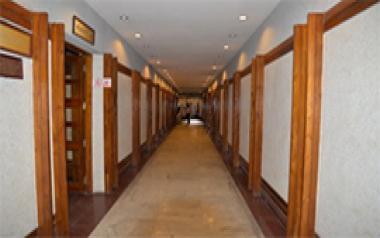The Assam State Museum was established on 21st April in 1940. The Kamrupa Anusandhana Samiti which was the pioneer organization in the field of historical and antiquarian studies of Assam had established the Assam State Museum. The museum was formally inaugurated by the Governor of Assam Sir Robert Neil Reid.
Rai Bahadur Kanaklal Barua, Raibahadur Ananda Chandra Agarwalla, Late Rai Bahadur Kali Ram Medhi, their untiring efforts were greatly responsible for establishment of the Museum.
The first building of the museum was constructed with the money received from public donation and Government grant. Raibahadur Naupat Rai Kedia has donated a handsome amount for the construction of the building. In 1953 the institution was taken over by the state Government.
The exhibits of the museum are displayed in different galleries
- Freedom Fighter gallery: It is a pictography gallery. It includes the photographs on the life history of Mahatma Gandhi and some photographs of martyrs of Assam of the Quit India movement.
- Painting Gallery:This is painting gallery. It houses some of the paintings by the modern painters of Assam. Some of the notable Paintings are Battle of Kurukshetra by Ramesh Ghosh, last stage of Sati Joymati by Mukta Bordoloi, Bodo weavers by Benu Mishra, Village scene of Assam by Lambodhar Hazarika
- Ethnography gallery:Arts and artifacts of different groups of the tribal population of Assam are displayed here. At present the tribes which are represented in the section are 1. Bodo, 2. Dimasa, 3. Rabha, 4.Tiwa, 5. Mishing, 6. Hajong, 7. Sonowal Kachari, 8. Kuki, 9. Jemi Naga, 10. Hmar, 11. Khelmas, 12. Deori etc.
- Village life of Assam:Some aspects of the village life of Assam have been depicted in this gallery. A model of an Assamese household, model of cottage industries and a model of namghar are also displayed here.
- The Sculpture gallery:This is the sculpture gallery. Majority of the sculptures were fashioned in the pre Ahom period belonging to 6th to 13th century. Nataraja, Vishnu, Mahasimardini are some sculptures that were discovered by the archaeological excavations at Ambari. This gallery includes some sculptures received from the Bharat Kala Bhavan and Benaras Hindu University
- The Manuscript gallery: The manuscripts are in old Assamese, Tai, Burmese etc. These are written in Sanchipat, Tulapat and Tal pat. Some of the Assamese manuscripts preserved here are also illustrated with colours.
- Arms and Ammunition Gallery:This is the Arms and Ammunition Gallery and displays the Cannons of Ahom, Koch and Mughal period and swords, Hengdan, daggers, Shields of medieval period and modern specimens of arms and ammunitions which were used by the Japanese army and air force during the Second World War are displayed here.
- Epigraphy Gallery:This is the Epigraphy Gallery. Stone and copper plate inscriptions belonging to the period from 5th century to 18th century AD are displayed here.
- Pre and Proto historic and terracotta galleryIt showcases the original specimen collected from Archaeological survey of India dating to the Indus valley civilization. It was discovered during the exploration and excavation of the sites at Harrapa and Mohenjodaro. This gallery includes Terracotta objects collected from various places of Assam and North East India.
- Numismatics and metallic sculpture Gallery: Some metal sculpture – Mahasimardini, Vishnu, Buddha are displayed here. Coins of Ahoms, Coins of Mughal period are showcased here. The Museum has a coin cabinet with more than 6000 coins of different period.
- The textile Gallery:Costumes of late medieval period, pat chaddar, Muga chaddar Riha Muga and silk dresses of Men and women are displayed here, including the royal gown.
- Wood craft Gallery:This is the wood craft Gallery. Wood carving has been very popular in Assam from ancient times. This galley displays the expertise of wood carving in Assam particularly the Vaishnava satras. The various tribes are the principal practitioner in the field of wood craft.
- Natural History Gallery:Assam is abundant with natural forest and various kinds of flora and fauna. This gallery depicts the world famous one horn rhino and other animals and birds and their habitat areas in different in parts of Assam particularly Kaziranga and Manas national Park.
- The North East Gallery The North eastern part of India is inhabited by many tribes, both in plains and hills.Most of the tribe's women practice weaving by their own indigenous methods. The NE gallery's textile section exhibits different types of colourful clothes and costumes of their products.


